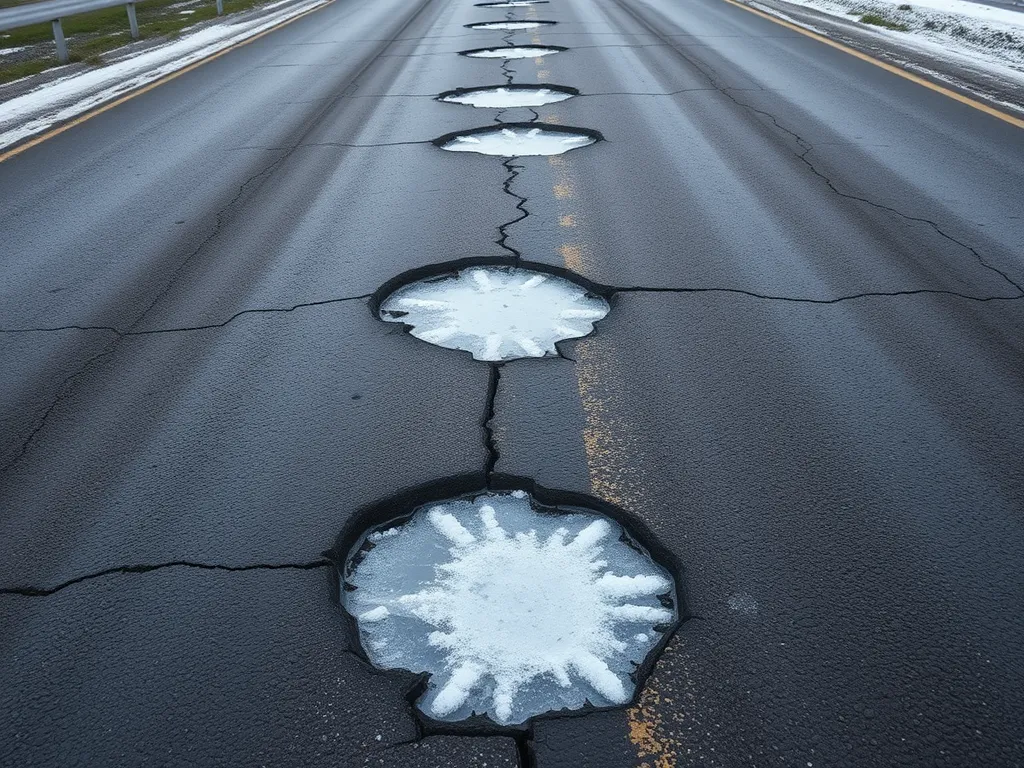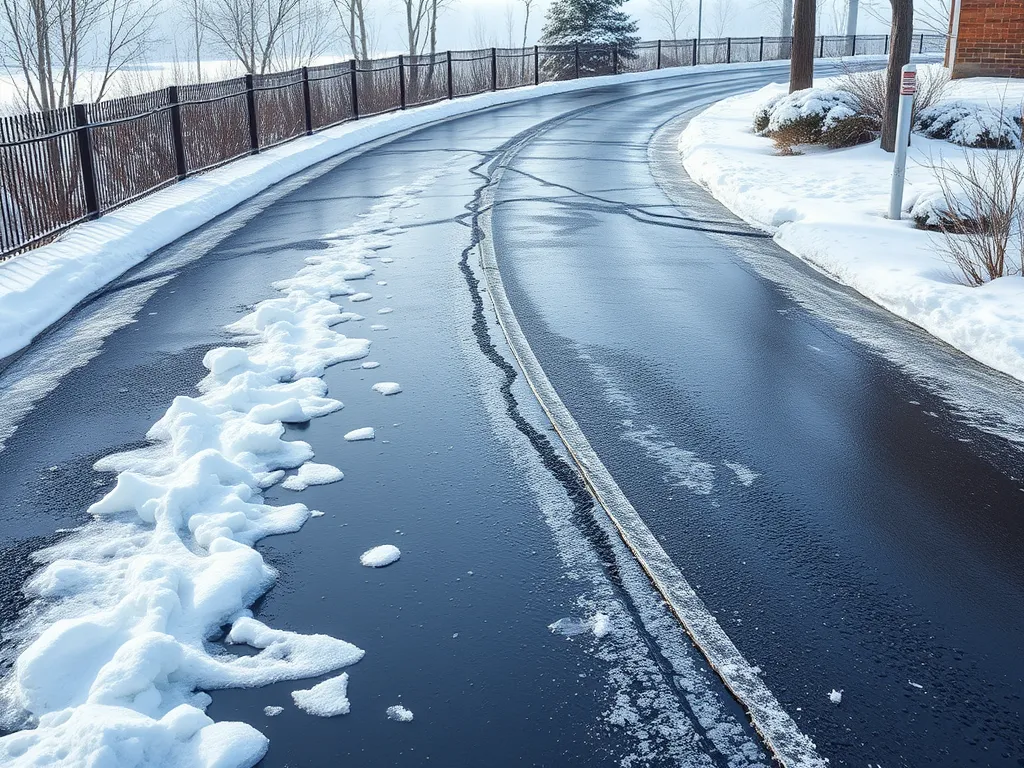Does Rock Salt Damage Asphalt? The Cold Truth
Published on: November 20, 2025 | Last Updated: April 14, 2025
Written By: George Voss
Yes, rock salt damages asphalt. Sodium chloride (rock salt) melts ice by lowering water’s freezing point to 15°F, but it triggers chemical reactions that break down asphalt binder. This weakens pavement over time, causing cracks, potholes, and surface erosion. Repeated freeze-thaw cycles worsen damage as saltwater seeps into tiny pores, expands when frozen, and splits the asphalt matrix. Proper application methods and sealcoating reduce risks.
This article explains how rock salt interacts with asphalt, compares it to safer alternatives like calcium chloride or magnesium chloride, and provides actionable steps to protect driveways and roads. You’ll learn why 22% of asphalt deterioration in snowy regions links to de-icing salts, how to apply sealants every 2-3 years, and which eco-friendly options prevent harm to soil and groundwater.
Contents
Understanding Rock Salt and Its Use on Asphalt
Rock salt remains a go-to winter solution for many, but its effects on asphalt surfaces spark debates. Let’s break down its properties and why it’s so widely adopted.
What is Rock Salt?
Rock salt, or sodium chloride (NaCl), is a mineral mined from underground deposits. It shares chemical similarities with table salt but contains impurities like calcium sulfate and magnesium chloride. These elements lower its freezing point to around 15°F (-9°C), enabling ice melting at moderate winter temperatures. The jagged granules provide traction while dissolving into brine that penetrates thin ice layers.
Why is Rock Salt Commonly Used for Snow and Ice Removal?
Speed and simplicity drive rock salt’s popularity. Unlike liquid de-icers requiring specialized equipment, it’s spread manually or with basic spreaders. Municipalities and homeowners favor its rapid action—melting starts within 15 minutes of application. It’s also non-flammable and stores indefinitely in dry conditions, making it a low-maintenance option.
Cost-Effectiveness and Accessibility
At $50–$70 per ton, rock salt costs 60% less than calcium chloride and 80% less than potassium acetate. Bulk purchasing cuts expenses further, with road crews using 10–12 million tons annually across the U.S. Hardware stores stock 10–50 lb bags year-round, and suppliers maintain regional stockpiles for winter storms. This accessibility makes it a default choice despite risks to asphalt longevity.
While rock salt tackles ice effectively, its chemical and physical impacts on asphalt demand closer inspection. Let’s explore how repeated exposure weakens pavement over time.
How Rock Salt Damages Asphalt
Rock salt (sodium chloride) interacts with asphalt surfaces through chemical and physical processes. These interactions gradually weaken pavement structure, leading to visible damage over time.
Chemical Reactions Between Rock Salt and Asphalt
Salt ions penetrate asphalt binder (bitumen), triggering oxidation. This process breaks hydrocarbon chains in bitumen – the glue holding aggregates together. Weaker binder means reduced flexibility.
Oxidation and Surface Degradation
Oxidized asphalt becomes brittle, causing surface raveling. Aggregate particles loosen, creating rough textures. Studies show salt exposure increases binder oxidation rates by 18-22% compared to untreated surfaces.
Physical Effects Of Freeze-thaw Cycles
Salt lowers water’s freezing point to 15°F (-9°C), creating repeated melting/refreezing. Liquid water seeps into micro-cracks during thaws, expands by 9% when freezing, generating up to 2,100 psi pressure.
Expansion and Cracking
This pressure fractures asphalt from within. A 1/8″ crack can become 1/2″ wide after three freeze-thaw cycles with salt use. Joints and edges fail first due to stress concentrations.
Long-term Impact on Asphalt Integrity
Annual salt application cuts asphalt lifespan by 3-5 years. Pennsylvania DOT reports salt-treated roads require rehabilitation 32% more frequently than those using alternative deicers.
Accelerated Wear and Tear
Compromised surfaces develop potholes 2-3x faster. Salt-contaminated asphalt shows 40% higher rutting potential under traffic loads. Base layers erode as water infiltrates through damaged surfaces.
While rock salt remains a popular winter solution, its effects on pavement demand careful consideration. Let’s examine how alternative de-icing agents compare for asphalt preservation.

Rock Salt Vs. Other De-icing Agents for Asphalt
Picking the right ice melt matters for asphalt care. Rock salt (sodium chloride) works but risks harm. Compare it to other agents to find safer options.
Comparing Rock Salt to Calcium Chloride
Calcium chloride melts ice faster than rock salt. It works down to -25°F vs. rock salt’s 20°F limit. But calcium chloride draws more moisture, which may speed up asphalt cracks. Costs run $100-$200 per ton—double rock salt’s $60-$150 range. Both release chlorides, harming soil and plants near roads.
Magnesium Chloride: A Gentler Alternative?
Magnesium chloride melts ice at 0°F with less grit than rock salt. It leaves less residue on asphalt, cutting scrub wear. But overuse can still dry out binders. At $150-$250 per ton, it’s pricier but lasts longer per pound. Test small zones first to check surface reaction.
Non-chloride Alternatives for Asphalt Safety
Chloride-free options avoid chemical harm but trade-offs exist. They cost more and melt slower, yet protect asphalt long-term.
Calcium Magnesium Acetate (CMA)
CMA blends limestone and acetic acid. It breaks ice above 20°F without chlorides. Safe for new asphalt but needs 2x the amount of rock salt. Priced at $300-$500 per ton, it’s best for eco-focused sites like parks.
Urea and Potassium Acetate
Urea (common in fertilizers) melts ice at 15°F but washes off fast. Use it with sand for grip. Potassium acetate works below -15°F, ideal for airfields. Both cost $400-$700 per ton and lack chlorides, sparing asphalt from oxidation.
Each choice affects asphalt life and winter safety. Next, learn how to apply these agents while shielding your pavement.
Also See: Excavation Strategies for Asphalt Paving
Preventing Rock Salt Damage to Asphalt
While rock salt remains widely used for snow management, proactive strategies reduce its harmful effects on paved surfaces. Proper techniques preserve structural integrity without sacrificing winter safety.
Best Practices for Applying Rock Salt
Strategic use limits chemical exposure. Focus on high-traffic zones like driveways or walkways, avoiding broad, indiscriminate spreading.
Minimizing Quantity and Frequency
Use 4-6 ounces per square yard—enough to melt ice without oversaturation. Pre-wet crystals with water to boost effectiveness, cutting required volumes by 20%. Reserve applications for storms exceeding 2 inches or when black ice forms.
Protective Measures for Asphalt Surfaces
Physical barriers shield against salt penetration. Combine these with timely snow management for optimal results.
Sealcoating as a Barrier
Coal-tar or asphalt-based sealants block moisture and chlorides. Professionally applied layers last 2-3 years, reducing crack formation by 50%. Schedule treatments during dry, warm months for maximum adhesion.
Prompt Snow Removal and Cleaning
Clear snow within 12 hours using plastic-edged shovels. Metal blades scrape surfaces, creating entry points for salt. After thawing, rinse residues with low-pressure water (under 1,200 PSI) to prevent buildup in pores.
Routine Maintenance to Mitigate Damage
Regular checks catch early warning signs. Inspect paved areas each spring for ravelling, spalling, or cracks wider than 1/4 inch. Fill gaps using rubberized crack filler ($12-$25 per gallon) before winter. For deeper damage, infrared patching ($3-$5 per sq. ft.) bonds fresh mix to existing pavement, restoring seamless surfaces.
While these steps minimize harm from salt on road asphalt, considering broader ecological consequences remains vital. Next, we’ll explore how chloride runoff affects surrounding ecosystems.

Environmental Impact Of Rock Salt on Asphalt Ecosystems
Rock salt doesn’t just threaten asphalt surfaces—it disrupts surrounding ecosystems. Sodium chloride runoff from treated roads and driveways spreads far beyond pavement edges, creating ripple effects in soil, water, and plant life. Let’s break down how this happens and explore safer options.
Runoff Contamination and Soil Health
Every pound of rock salt applied to asphalt dissolves into sodium and chloride ions. These seep into soil, raising salinity levels up to 10x normal concentrations within 15 feet of roads. High salinity:
- Compacts soil, reducing water infiltration by 30-50%
- Kills beneficial microbes needed for nutrient cycling
- Stunts root growth in nearby plants and trees
Chloride runoff flows into streams and groundwater, exceeding EPA’s 230 mg/L toxicity threshold in 40% of urban waterways. Aquatic species like trout and frogs show 20-30% population declines in high-salt zones.
Eco-friendly Alternatives and Their Benefits
Switching de-icers can cut chloride pollution by 70-100% while protecting asphalt. Top options include:
| Alternative | Chloride Content | Effective Temp | Cost per Ton |
|---|---|---|---|
| Calcium Magnesium Acetate (CMA) | 0% | 15°F | $650 |
| Beet Juice Blend | 0% | -25°F | $300 |
| Potassium Acetate | 0% | -30°F | $900 |
| Sand/Grit | 0% | Any | $15 |
CMA prevents freeze-thaw damage to asphalt pores. Beet juice lowers melting points without corroding pavement binders. While pricier upfront, these options reduce long-term asphalt repair costs by 18-22% compared to rock salt.
Managing ice safely requires more than swapping products—it demands smart application. Let’s explore how to apply de-icers without sacrificing pavement or ecosystems.
Frequently Asked Questions (FAQs)
Is Rock Salt Safe for an Asphalt Driveway?
No, rock salt can harm asphalt driveways over time by promoting chemical reactions that degrade the asphalt binder. These reactions can lead to surface cracking, potholes, and overall deterioration of the asphalt surface.
What is the Safest Ice Melt for Asphalt?
Eco-friendly alternatives such as Calcium Magnesium Acetate (CMA) or blends that include beet juice are generally considered safer for asphalt. These alternatives do not contain chlorides, which can cause oxidation and damage to asphalt.
Does Calcium Chloride Damage Asphalt?
Yes, calcium chloride can also damage asphalt, albeit at different rates than rock salt. It tends to draw moisture, which can lead to accelerated cracking in asphalt surfaces. Care should be taken when using it on asphalt.
How Long Does It Take for Rock Salt to Damage Asphalt?
While the onset of damage can vary based on conditions, regular exposure to rock salt can begin to show noticeable effects, such as cracking and surface wear, within a few seasons. Over time, its use can reduce the lifespan of asphalt by several years.
What’s the Best Salt for an Asphalt Driveway?
The best option for an asphalt driveway is one that minimizes potential damage while effectively melting ice. Consider using Calcium Magnesium Acetate (CMA) or other non-chloride alternatives. If you must use a salt, magnesium chloride may be a better choice than rock salt due to its lower reactivity with asphalt.

Closing Thoughts
Rock salt, while popular for its cost-effectiveness in snow and ice removal, can pose challenges for asphalt surfaces. Its chemical properties lead to oxidation, surface degradation, and the physical stress of freeze-thaw cycles, which can accelerate wear and tear on asphalt. Understanding these effects is crucial for homeowners and property managers to maintain the integrity of their asphalt driveways and roads.
Choosing the right de-icing agent is vital. Options like calcium chloride and non-chloride alternatives can be more gentle on asphalt, providing safer choices for winter maintenance. Regular maintenance practices, such as sealcoating and prompt snow removal, further help protect asphalt from potential damage.
For comprehensive information and tools to help you manage your asphalt needs, check out Asphalt Calculator USA.


